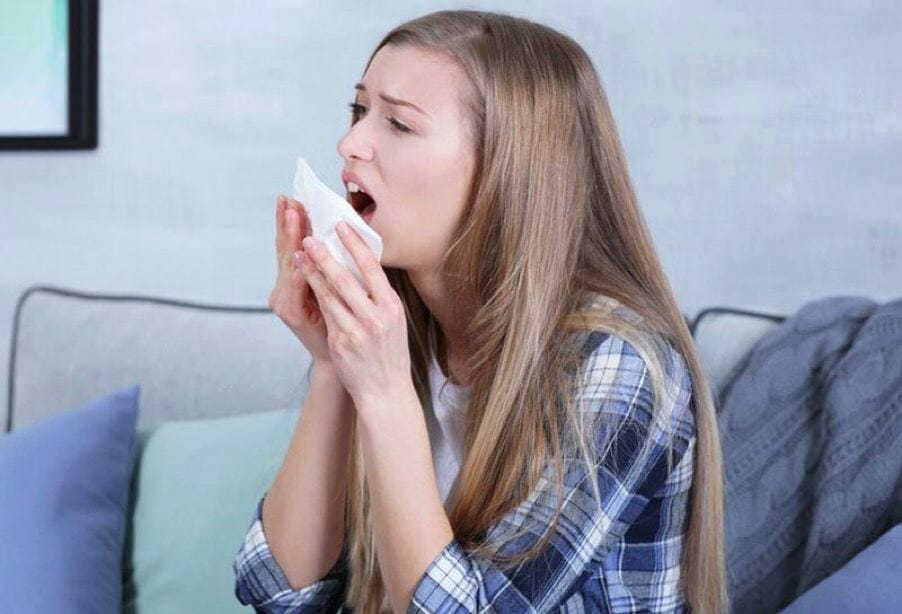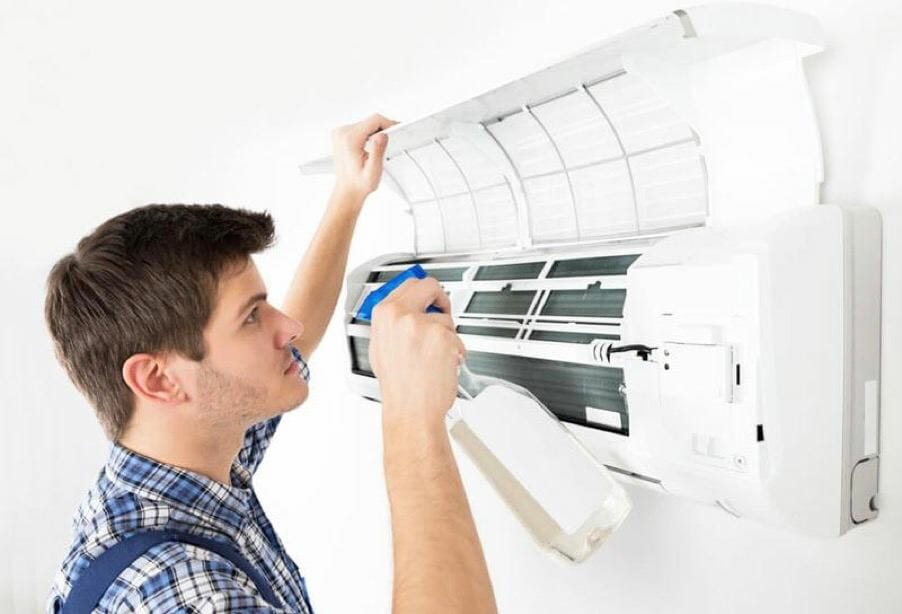Discovering mold within your home can cause concern, and the decision to engage a professional service may hinge on the mold’s location and its extent.
If a visible mold path measures more than 3 feet by 3 feet or if mold is found in more than 1 room of your home, you should seek professional remediation. Anything smaller can be removed with retail mold cleaners with ease.
According to guidelines set out by the United States Environmental Protection Agency (EPA), mold growths of this size are considered too extensive to be dealt with independently.
There are some early warning signs that tell you whether you might have a mold problem. Read on for more details.
Four warning signs that you might need mold remediation
While measuring any visible mold growth in your home is one of the best ways of determining whether you need mold remediation, it may not always be possible to rely on this method alone.
Hidden mold, or mold that grows out of sight in out-of-the-way places, can pose just as serious a risk as visible mold growths. This hidden mold can grow anywhere, from behind your wallpaper to underneath your carpet.
We’ve identified four key warning signs to watch out for that might indicate that you need mold remediation.

1. A musty odor
One of the most common signs of old-growth, whether visible or hidden, is a dank, musty odor in your home. This musty odor tends to linger, no matter how much you clean or air out your home.
Certain compounds, known as microbial volatile organic compounds, are the cause of this musty, unpleasant mold smell. Once mold begins to grow in your home, these compounds are quickly released into the air, taking their tell-tale smell with them.
If you have a constant musty odor in your home that is proving stubborn and hard to get rid of, you may have a hidden mold growth that needs to be addressed.

2. Discoloration or peeling of your walls
Mold thrives in cellulose-rich environments, such as those presented by drywall or Gypsum board. If there is a dampness issue within the walls of your home – perhaps a leaking pipe or cracked foundations – it is much easier for mold to infiltrate and begin to grow rapidly.
Although mold growths such as these may not be immediately visible, they will soon start to show themselves on your walls. The wallpaper will begin to crack and peel as a result of excess moisture, and painted walls may begin to display discolored patches.
If you notice either of these signs on the walls of your home, you can almost be certain that you have a moisture or dampness issue. And where there is a moisture or dampness issue, mold growths tend to follow closely behind.
3. Health symptoms including respiratory issues and rashes
While many people can live in a home with hidden mold and not come down with any health issues, people with mold allergies or asthma can suffer quite badly.
For mold allergy sufferers, common symptoms will soon present if they live in a moldy environment. Respiratory issues are one of the most common symptoms, resulting from breathing in tiny, microscopic mold spores. Runny noses, sneezing, coughing, and difficulty breathing are all signs of an active mold allergy.
Similarly, for asthma sufferers, breathing in mold spores can cause them to suffer from a range of symptoms. Most often, exposure to mold will cause an asthmatic’s usual symptoms to worsen. In extreme cases, however, prolonged and excessive exposure to mold spores can even trigger an asthma attack.

4. Flooding or water damage
Water damage from a water leak or flooding can quickly lead to a severe mold issue. Once the water issue has been fixed you will need to dry out the affected areas asap.
Mold can start growing within a few hours under the right conditions, so you will need to do a thorough check to make sure you are in the clear.
Getting a mold inspection or an air mold testing kit is the first set to ensure you are mold-free. If you find mold, don’t wait. Get pro remediation from local services.

How to prevent mold
You can do a few things to prevent mold from developing in the first place. Here they are in no particular order:
- Keep humidity low – Once humidity gets above 50% and stays there for an extended period, mold can easily grow in your home. Use a dehumidifier to keep humidity levels in check.
- Ventilation – Letting your home breathe is key. Keep air circulating by opening windows and doors each day.
- Wash moldy clothes – Mold can begin growing in dirty laundry quite quickly, so be sure to wash your clothes regularly and hang them outdoors in direct sunlight to kill mold spores.
Common areas to check for mold
Certain areas and rooms within your home are more susceptible to mold growth than others. Mold needs dampness and moisture to grow, so the parts of your home that experience more water exposure are more likely to have significant amounts of mold.
Areas and parts of your home and property that more commonly experience mold growth include:
- Bathrooms
- Kitchens
- Laundries
- Drywall
- Roofs
- Attics
- Windows
- Pipes
- Furniture
- Upholstery
Should I get an air test for mold?
According to the Centers for Disease Control and Prevention (CDC), there is no safe level of mold. As such, they do not recommend any type of testing for mold, whether that be a swab test or an air test. Instead, they recommend that you simply remove any mold growths as soon as they become noticeable.
However, if you cannot see any mold growths in your home but still suspect you may have a mold problem, a mold air test can determine whether there is indeed an excessive number of mold spores in your home.
A mold air test will measure the number of mold spores per square meter of air. While there is no agreed upon level at which the number of mold spores can be considered safe, a mold spore test can be a useful tool to help discover whether you have any hidden mold in your home or property.
Process for mold remediation
If you decide to proceed with professional mold remediation, the exact process that your mold remediation professional utilizes will depend on your individual circumstances.
The extent and location of your mold growths will dictate the products and processes to be used, but each mold remediation will follow the basic steps set out below.
- Identification: Your mold remediation professional will identify the location and source of your mold issue, including any underlying dampness or moisture issues.
- Containment and protection: In addition to determining the appropriate levels of personal protective equipment required for the remediation process, your mold remediation professional will contain any existing mold growths to prevent their further spread.
- Remediation: Pay a mold remediation professional will fix any underlying moisture or dampness issues, and then begin the process of removing the mold growths through the use of specialized chemicals and equipment.
- Removal and disposal: In addition to removing and disposing of any containment materials used throughout the remediation process, your mold remediation professional may need to remove and dispose of any unsalvageable items or materials from your home.
How much does mold removal cost?
The cost of mold removal will depend on a number of factors, including the size and location of your mold growth as well as any disposal or repairs that may be required.
On average, mold remediation costs between $1,500–$3,150 per project. This equates to approximately $15 to $30 per square foot.
However, smaller remediation jobs can cost as little as $500. Areas such as shower recesses, which are prone to mold growth but are fairly open and relatively small, can be easily and inexpensively remediated.
Mold remediation scams to be on the lookout for
Although they are relatively rare, there are mold remediation scams out there. If you familiarize yourself with the basics of mold remediation and know some of the common signs of a mold remediation scam, you can prevent yourself from falling victim to one of these scams.
Some of the mold remediation scams you should be on the lookout for include:
- A quote or estimate that does not address or remedy the underlying moisture issues.
- Requesting a fee for a mold-free certificate for your home.
- Requiring you to pay the full fee upfront.
- Offering only a cursory visual inspection before finding mold in your home.
- Providing no evidence of certifications or licensing.
- A mold remediation company with no online presence.
The features of mold remediation scams listed above are by no means a comprehensive list. The best way to guard against mold remediation scammers is to educate yourself about the basics of mold remediation and engage with any professionals who inspect your home and provide you with a quote.







